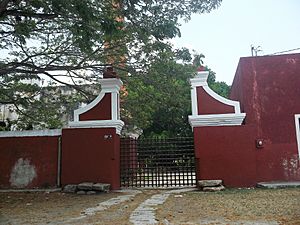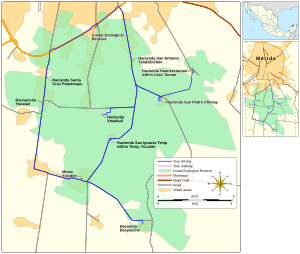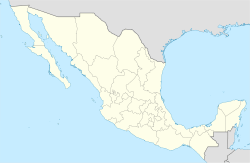Hacienda San Pedro Chimay facts for kids
Quick facts for kids
Hacienda San Pedro Chimay
|
|
|---|---|
|
Private Residence
|
|

Entrance
|
|

Cuxtal Ecological Reserve
|
|
| Country | Mexico |
| Mexican States | Yucatán |
| Municipalities | Mérida Municipality |
| Time zone | UTC−6 (CST) |
| • Summer (DST) | UTC−5 (CDT) |
| Postal code |
97316
|
| Area code | 999 |
Hacienda San Pedro Chimay is a historic estate found in Mérida Municipality, in the Yucatán state of southeastern Mexico. It was built during the 1800s when a plant called henequen was very important for the economy. Today, it is part of the Cuxtal Ecological Reserve, which was created in 1993. This reserve helps protect the old buildings and the nature around Mérida.
Contents
What's in a Name? San Pedro Chimay's Meaning
The name San Pedro Chimay mixes two languages: Spanish and Maya. San Pedro is Spanish for Saint Peter, who is the patron saint of the hacienda's chapel. Chimay comes from the Maya language and refers to a type of Acacia plant.
Finding Hacienda San Pedro Chimay
You can find this historic property about 7 kilometers (about 4.3 miles) south of the main highway (Periférico) in Mérida. It is located on the road that goes from Mérida to Timucuy.
A Look Back: History of San Pedro Chimay
This hacienda is one of the oldest estates near Mérida, built in the late 1500s or early 1600s. In the 1700s, it was owned by the family of Bonifaz Lara, who came from Spain.
Important Owners and Changes
In 1852, Juan Miguel Castro, who founded the Port of Progreso, rebuilt his wife's family home. He even put up a special plaque to honor his wife, María de Jesús Lara.
After the Castro Lara family, the estate went to the Cervera family. Later, in 1982, José Eduardo Seijo Gutierrez bought the hacienda. His family now uses it as their "country home." They enjoy its nice pool and a garden where they grow vegetables.
Part of the Cuxtal Ecological Reserve
On June 28, 1993, the Cuxtal Ecological Reserve was created. This special area was set aside to protect the history of seven large haciendas, their nearby villages, and many other important sites. These sites include 12 smaller archaeological spots, 6 natural cenotes (water-filled sinkholes), and one of Mérida's main water sources. Hacienda San Pedro Chimay is an important part of this protected reserve.
The reserve protects these other haciendas too:
- Hacienda Hunxectamán in the village of Uxec Taman
- Hacienda San Antonio Tahdzibichén
- Hacienda San Ignacio Tesip in the village of Tesip
- Hacienda San Nicolás Dzoyaxché, which has a cenote called Dzonot-Ich
- Hacienda Santa Cruz Palomeque
- Hacienda Xmatkuil
Exploring the Architecture of San Pedro Chimay
The hacienda has two main entrances. The southern entrance is older. The northern entrance was built in 1852 when the property was rebuilt. This northern entrance has a single arch with large stone pillars and a special diamond shape in the center.
The Main House and Its Unique Features
The main house might have been built on top of an even older structure from before the Spanish arrived. In one part of the house, a stone in a column looks different from the others. It might have come from an ancient Maya temple! A special feature of this hacienda is its wide hallway with many arches supported by decorative pillars.
The main buildings show designs from the colonial period. After being rebuilt in the 1800s, the property faced some tough times. But recently, it has been restored, and a new open area was built. The back of the main house, facing south, also has grand arches and fancy stone pillars. The windows are decorated with stucco designs from the colonial style. At the very top of the building, you can see neoclassical decorations and carved stone pipes.
Outdoor Spaces and Water Features
On the west side of the main house, there is a green area. This used to be where the kitchen was, and below it were workshops for carpentry and storage for sisal bales (from henequen plants). Another large green space leads to the main house entrance. To the east, you'll find the old stables.
Further east, there is a large brick terrace with French-style mosaic tiles, a swimming pool, and a fountain. The pool gets its water from three wells, which are fed by a cenote located under the terrace. The edge of the pool is made of stone. There is also a large water tank with stone stairs. A wide stone staircase connects to the northern entrance of the main house, where you can see styles from the 1800s, like neoclassical and French designs.
Inside the Hacienda
At one end of a large open area, there are two fireplaces. One has a special Moorish design. On the side of the thinner chimney, you can see the initials "JMC" and the date "January 1875." The wider fireplace is older and was used for the mill. In this same area, you can find the powerhouse and all the machinery used for processing henequen.
The Church of San Pedro Chimay
The church is on the left side of the house, surrounded by big trees. Its bell tower has three spaces decorated with green and ivory ceramic cups. A copper bell hangs in one of these spaces. A metal cross is attached to the front of the church.
Inside, there is a wooden altar with gold leaf details. There is also a small choir area with a fancy wooden railing. You can reach the choir by a stone staircase outside the chapel. At each end of the altar, there are statues of Jesus of Nazareth and the Virgin Mary.
People of San Pedro Chimay: Demographics
Before 1937, many people lived and worked on the henequen plantations. However, in 1937, President Lázaro Cárdenas made a new law about land. This law changed the haciendas into collective farms called ejidos. The former landowners were only allowed to keep 150 hectares (about 370 acres) for their private use.
Because of this change, the population numbers before 1937 show how many people lived on the farm itself. After 1937, the numbers show how many people lived in the community around the hacienda. Today, Hacienda San Pedro Chimay is mainly home to the owner's family.
According to a census in 2005 by the INEGI, the community of San Pedro Chimay had 1012 residents. This included 516 men and 496 women.
| Year | 1900 | 1910 | 1921 | 1930 | 1940 | 1950 | 1960 | 1970 | 1980 | 1990 | 1995 | 2000 | 2005 |
|---|---|---|---|---|---|---|---|---|---|---|---|---|---|
| Population | 205 | 465 | 349 | 272 | 216 | 275 | 365 | 430 | 614 | 726 | 862 | 930 | 1012 |
Images for kids
See Also
 In Spanish: San Pedro Chimay para niños
In Spanish: San Pedro Chimay para niños














